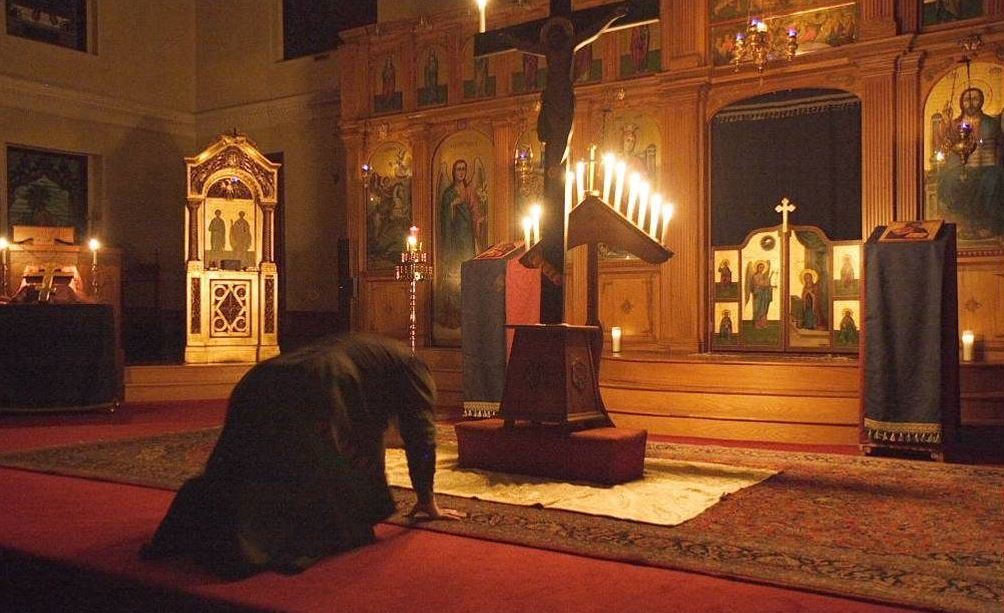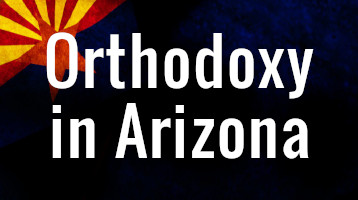
The Great Canon of St Andrew, Bishop of Crete, is the longest canon in all of our services, and is associated with Great Lent, since the only times it is appointed to be read in church are the first four nights of Great Lent (Clean Monday through Clean Thursday, at Great Compline, when it is serialized) and at Matins for Thursday of the fifth week of Great Lent, when it is read in its entirety (in this latter service, the entire life of St Mary of Egypt is also read).
There is no other sacred hymn which compares with this monumental work, which St Andrew wrote for his personal meditations. Nothing else has its extensive typology and mystical explanations of the scripture, from both the Old and New Testaments. One can almost consider this hymn to be a “survey of the Old and New Testament”. Its other distinguishing features are a spirit of mournful humility, hope in God, and complex and beautiful Trinitarian Doxologies and hymns to the Theotokos in each Ode.
The canon is a dialog between St. Andrew and his soul.
The ongoing theme is an urgent exhortation to change one’s life. St Andrew always mentions his own sinfulness placed in juxtaposition to God’s mercy, and uses literally hundreds of references to good and bad examples from the OT and NT to “convince himself” to repent.
A canon is an ancient liturgical hymn, with a very strict format. It consists of a variable number of parts, each called an “ode”. Most common canons have eight Odes, numbered from one to nine, with Ode 2 being omitted. The most penitential canons have all nine odes. Some canons have only three Odes, such as many of the canons in the “Triodion” (which means “Three Odes”).
In any case, all Odes have the same basic format. An “Irmos” begins each Ode. This is generally sung, and each Irmos has a reference to one of the nine biblical canticles, which are selections from the Old and New Testament, which can be found in an appendix in any complete liturgical Psalter (book of Psalms, arranged for reading in the services). A variable number of “troparia” follow, which are short hymns about the subject of the canon. These are usually chanted, and not sung. After each troparion a “refrain” is chanted. At the end of each Ode, another hymn, called the “Katavasia”, either the Irmos previously sung, or one like it is sung.
The troparia of the Great Canon in all its twelve Odes are usually chanted by the priest in the center of the church, with the choir singing the Irmos and Katavasia. There are varying traditions about bows and prostrations. Some prostrate and some make the sign of the cross and bow three times after the Irmos and each troparion.

General Themes of the Great Canon.
How we should think about ourselves
Where shall I begin to lament the deeds of my wretched life? What first-fruit shall I offer, O Christ, for my present lamentation? But in Thy compassion grant me release from my falls. Mon:1.1
Desire to change – dialogue with the soul
Come, wretched soul, with your flesh, confess to the Creator of all. In the future refrain from you former brutishness, and offer to God tears of repentance. Mon:1.2
Recognizing Reality
The end is drawing near, my soul, is drawing near! But you neither care nor prepare. The time is growing short. Rise! The Judge is at the very doors. Like a dream, like a flower, the time of this life passes. Why do we bustle about in vain? Mon:4.2
How to pray – Laments and supplications to God
Thou art the Good Shepherd; seek me, Thy lamb, and neglect no me who have gone astray. Mon:3.5
OT and NT examples of righteousness and unrighteousness, for the purpose of emulation or avoidance.
Do not be a pillar of salt, my soul, by turning back; but let the example of the Sodomites frighten you, and take refuge up in Zoar.(Genesis 19:26) Thurs Ode 3:5
I have reviewed all the people of the Old Testament as examples for you, my soul. Imitate the God-loving deeds of the righteous and shun the sins of the wicked. Tues Ode 8
The Most Important Thing to Know about the Great Canon
The Great Canon was written by a holy man to teach himself the right way to live. We cannot benefit from it unless we make it a priority to stand in prayer, in the church, and listen to it, with a great desire and expectation for God’s grace to teach us and heal us. Our theology is first and foremost – experienced and prayed, and not only “studied”.



